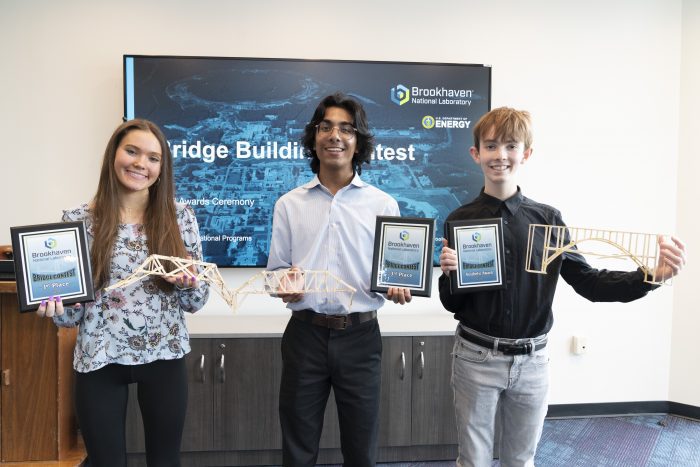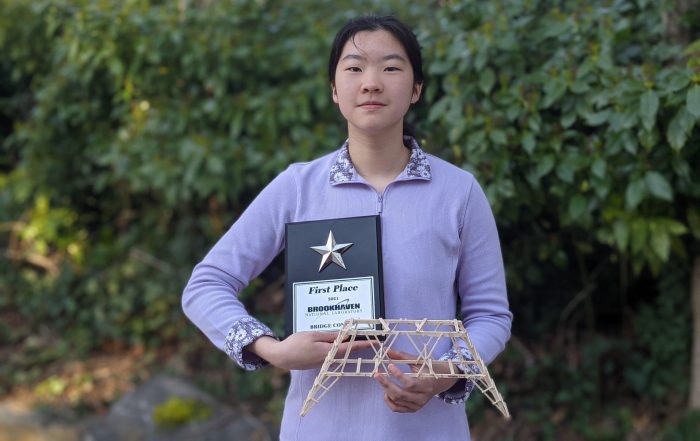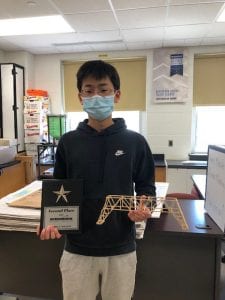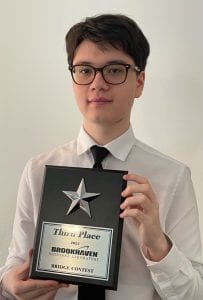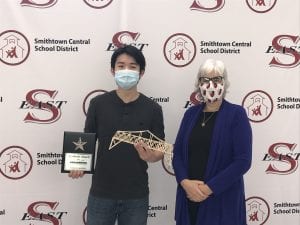High school students become model bridge engineers in annual contest
Jacqueline Seifert, a senior at Commack High School, won first place in the 2023 Bridge Building Competition hosted by the U.S. Department of Energy’s (DOE) Brookhaven National Laboratory on March 30.
The annual contest puts model bridges constructed by Long Island High School students to the ultimate pressure test. Students apply physics and engineering principles to build basswood structures to a set of specifications. Then, their bridges are judged based on efficiency, which is calculated using the mass of the bridge and the amount of weight it can support before breaking or bending more than one inch.
“This competition is an introduction to the world of engineering,” said Scott Bronson, manager for K–12 programs at the Lab’s Office of Educational Programs (OEP). “At Brookhaven Lab, engineers of all types support our science goals at world-class facilities and the DOE mission. We hope this contest inspires students to explore paths in science, technology, math, and engineering and to return to the Lab as interns and future employees.”
OEP received a total 142 bridges, of which 91 qualified for testing, captured below.
An awards ceremony to honor the winners was held at Brookhaven Lab on April 6. The top two winners in this regional competition qualify to compete in the International Bridge contest on April 29 in Chicago, IL.
Seifert, who earned second place in last year’s local competition and placed 16th in the previous international contest, designed a bridge that weighed 23.47grams and recorded an efficiency of 1342.22. As the testing machine slowly added more and more weight to Seifert’s W truss design, the Science Learning Center erupted in impressed “oohs” as the load hit close to 70 lbs. Retired Brookhaven Lab engineer and longtime competition supporter Marty Woodle noted right away “that’s an international contender.”
Seifert, who will pursue civil engineering at Vanderbilt University, said it was rewarding to watch her design hit that high bridge load. “The most exciting part was the experimentation and seeing what works and what doesn’t, finding the weak points in my bridge so I could continue to make it better,” she said. “I’ll see how it goes in the international competition.”
Katherine Liang, a junior at Ward Melville High School, who garnered first place in two previous contests and 9th and the last international competition, placed second this year with a design that realized an efficiency of 1094.44.
Third-place winner Jonathan Thomas, a junior at Walt Whitman High School, constructed a bridge that recorded an efficiency of 1048.18. After conducting bridge demos in a physics lab at school, Thomas learned his design needed more horizontal support and looked to previous competition winners for potential engineering ideas.“It’s definitely a career path I want to go into,” he said.
Aidan Quinn, a junior at Smithtown High School East won this year’s aesthetic award. Quinn’s double arch design was neat with clean lines, inspired by a photo his father showed him that captured a historical moment when a pilot flew a biplane under a bridge that once crossed the Niagara River.
“I would love to major in biomedical engineering,” Quinn said. “I’m glad I was able to participate in the competition. It was a great experience.”

